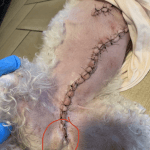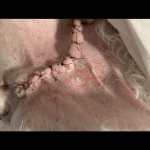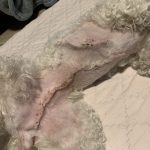Hello,
For these cases I talk a lot with owners about trying to identify the underlying cause. Often it is poor diet and sedentary life but there are also diseases and illnesses that can contribute. If able start to learn how to palpate your cats colon and feed watery wet food and use the fiber supplements and laxatives. Exercise is also very important. For these cats we start training in a harness to go outside for walks. I feel that if you don’t increase environmental enrichment and stimulation they won’t start moving.
But before all of this you have to remove the obstructive feces. This often needs a vets help. Call rescues and shelters and keep asking for affordable help.
My dog got spayed on August 1st, she is a 13 year old poodle mix. She also had a mastectomy along with her spay so she has a very big incision. She is on her 4th week and the lower half of her incision does not look like the top half. The surgeon said it may take a while to heal because of the placement but I noticed a bump at the base of her incision at day 4 that has not gone away. She keeps licking at it and the surgeon suggested we must let her heal and later investigate. Also, at day 10 I noticed a white tiny pimple sized thing trying to come through under her skin. I really checked it out today since it has not gone away and it feels like something sharp poking under her skin, she has two of these that feel the same. I am scared she might have torn her internal stitches but the surgeon did not seem too worried. I notice when she eats she seems to look like she feels uncomfortable. She threw up yesterday but I took it as maybe her pancreatitis acting up. I am freaking out and don’t know if I am making a big fuss over nothing. She did not run during her recovery but she would stand up on her hind legs no matter how much I attempted to keep her calm. She did slip 3 times and land on her tummy, twice at day 8 because I had her on a short leash and she would try to run, the third slip was at day 13 and for the same reason of the short leash and attempting to run. I feel so sad and don’t have peace of mind. I feel guilty she slipped on me those three times but then again don’t know what to make of that lump at day 4. After the two slips at day 8 and after on day 10 she started having severe diarrhea. I contacted the surgeons team and they suggested boiled chicken and boiled rice, but at day 12 the diarrhea was a soft serve ice cream consistency and then she thew up so I took her into emergency immediately. At emergency they checked her vitals and incision and could not figure out what may have caused the stomach upset since from her pancreatitis history did not have the swollen tummy and her incision looked fine. They attributed the upset to possible pain med side effect and prescribed a probiotic and to stop the gabapentin. It’s has been a tough healing process for her. I will attach pictures of of what the incision looked like at day 7, 10, and now. I hope it’s not what I am fearing but it’s better to know if I should advocate for her and have them check again. Thanks guys, sorry for the long story but this is my little girl who is my first owned dog and who has been by my side for 13 years. I love her so much and it pains me to see her uncomfortable. Fyi her appetite is always good no matter what and her bowels are back to normal since the 18th of august and they were fine before the 10th of august as well.
Comments
My 9 yr. old Megacolon cat Eli wasn’t able to poop. It happens sometimes. He’s on Cisapride and Merilax daily, but he still get’s backed up. When he started vomiting after not being able to BM and jumping out of the litter box I took him to the vet. They did an enema on June 20th. He’s still backed up! I can’t afford 1k plus to have a vet manually extract the feces (this is Washington, DC area – everything is very expensive!). He hasn’t started throwing up again, but he’s not eating much and I need to find out if there is something I can do more at home to get him through this emergent time. I can’t just watch my cat suffer. I have Pedi lax, but don’t know if that would help or hinder at this point. I watch videos on palpitating the colon to try and break up the feces. I know there are specific enemas to give cats at home. Is it too late to try this? My vet is frankly bad and too busy to bother, so she said to just go to the emergency. It sure seems like there are other steps that can be taken ,,,at least I hope so becuase I just don’t have that kind of money left with the cost for caring for my hospice Husky, Loki. Help!
Comments
6 week old kitten fell off the bed and hurt its back left leg. He can’t walk on it. He cries when it gets bumped. He can pull the leg against his body and lays on it, but when he stretched his leg out the top of his foot was facing out instead of forward. I’m worried he may have broken or dislocated something. How can I tell and what do I do? And what can we give him for pain?
Comments
Household “accidents”, need advice, please!! I have 3 cats, 3 dogs, and a toddler human. In the past few months my two youngest “house trained” dogs (9 & 5 yrs) and my youngest cat (4 yrs) have been purposely relieving themselves in different parts of my house. The dogs poop/pee on the floor, in the past month they began peeing on my couch, it’s gotten so bad I have to keep them in crates most of the time they’re inside. The cat will pee on my toddlers belongings – first on clothes in his laundry basket (which is now inside a closet) and on his stuffed animals (which I had to hide in a bin), now has resorted to peeing on any accessible hard plastic toys. If I put the cat in a kennel she uses the litter box 100% of the time, once releasing her she’ll behave for 1-2 days then starts up again. The dogs will have “accidents” within 10 minutes inside after being outside for 30-60+ minutes. I have 3 litterboxes, each with a different kind of litter, all clean, no diagnosed medical issues (taken all 3 to the vet twice since this started $$$). My oldest dog has been going through dementia for the past year, it’s getting worse but not yet at the point of euthanasia. I started preparing to move the past 6 months, house is almost done being packed/cleared. I’m not sure which/both/none are triggers for them acting this way. All of them have moved with me before and they never did this on previous moves. Vet prescribed multiple anxiety meds which are not helping at all, they have no other solutions to offer. Ironically my 14yr old dog with dementia barely ever has accidents in the house. Personality wise they aren’t acting any different. Messes are thoroughly cleaned immediately and they don’t even bother to do this secretively, all 3 seem to purposely do it right in front of me. The situation is driving me to my wits end, I really need help 🙁 Besides keeping them all in crates I have no other solution. Does anyone have insight to what I can do? Thanks so much!
Comments
My rescue dog is a Miniature Chihuahua and today she broke her front left leg and I have no funds to help her until I get my Disability check next month.I was already taking her to the vet as soon as my check came.I don’t know what to do, she is everything to me and in awful pain and I have Never felt so helpless in my life.We have a very strong bond and I love her so much please help her I don’t know what to do I just want to die for real please help Thank you Gina
Comments
Looking for information regarding polyps. In January of this year (2022) my then 3 1/2 year old cat developed what seemed like nasal congestion. She would snore, wheeze and “slurp” through her mouth. After 2 rounds of antibiotics they discovered she had a polyp under her soft pallet. After removal of the polyp her symptoms subsided a little but never completely. We then tried steroids but these did not help either. Now they are recommending I go to a specialist/internal medicine veterinary hospital to get a rhinoscopy and ct scan to see if there are additional polyps or some other kind of blockage. The initial consult visit would be $250 and the scoping and ct scan would cost $2500 to $3200. Is it common for cats to have more than one polyp and is there other treatments you would try before the very costly next step my vet is suggesting? I’ve already spent $1000 with what we have done so far so I am looking for any suggestions you can offer! I hate seeing her uncomfortable!! I should mention that she is not sneezing or coughing, but shake her head sometimes. She is eating fine and acting mostly fine except when lying down as that is when the difficulty breathing seems to get the worst.
Comments
My friend Spencer recently purchased a small male mouse from a pet store after seeing the awful condition the mouse was in. He named him Tucker. Tucker has a swollen eye and we aren’t sure from what since he was purchased that way but Spencer wants to treat him! We just don’t know what is wrong with Tucker or how this could have happened to him so we are looking for an answer possibly on what to do
Comments
How can you make a cats oversized bladder shrink?
I know it’s possible,
Do they need to be hospitalized?
I seen a video of a guy with a cat that has lower motor neuron bladder atony. He said his cat had a cath for 3 wks and it shrunk the bladder.
Also diapers… is it a guarantee that a cat will get a bladder infection from wearing a diaper or is it just a possibility? I see hertz has special diapers for cats n dogs, it doesn’t say if they will help block infections. We have an appointment the 23rd with the neurologist for a 2nd opinion. I was told mri is $4,500 to $8,400. We don’t know how to look at this situation or what to do. Our hearts are breaking at the thought of possibly saying goodbye to our 3yr old cuddle bug. He peed on me twice this morning while he was sleeping. I worry I am squeezing too hard, or that he is in pain.
Our 13 yo Cairn Terrier went to his usual grooming appt today. The groomer called me and said after his bath, he was crying constantly and seemed panicked. He was pacing and crying.
She thinks it may have been a seizure or something like it. When I picked him up from her, he was very happy to see me. We went home, he ate and is now acting like his normal self. The ER vet had a 10 hour wait! And no other vet can see him.
Comments
Help Dr. Magnifico of Jarrettsville Vet Our beautiful 13 year old Husky/beagle mix Sadie was struggling with getting up and climbing stairs because we thought her arthritis was getting worse. We took her in to the vet to get some pain medicine and they discovered that she has a large tumor on her spleen. We were told that the surgery is quite expensive. We are unable to afford much due to our current financial situation. The doctor suggested that we should euthanize her if we were not going to try to do the surgery. we have scheduled an appointment for tomorrow. 6/3 with lap of love.
My husband was looking for solutions because she is walking around and it is so hard for us to imagine putting her down. We saw the article by Dr. Magnifico. We tried to call Jarrettsville vet and they told us our only option was to put a question on here. Beth.a.acton@gmail.com













@kristamagnifico